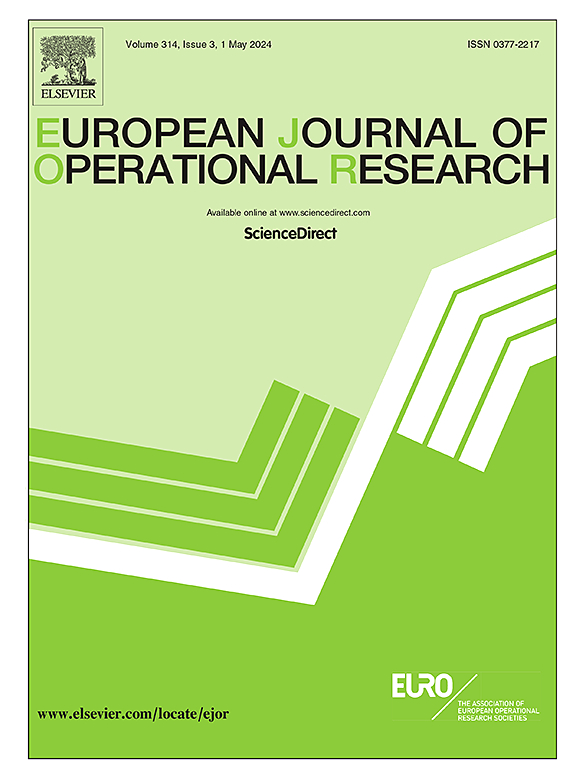具有沸腾现象的液化天然气双舱分送车辆路由问题的精确方法
IF 6
2区 管理学
Q1 OPERATIONS RESEARCH & MANAGEMENT SCIENCE
引用次数: 0
摘要
在本文中,我们研究了液化天然气(LNG)运输的双货柜车路由问题,以确定如何用船只将液化天然气从海外生产终端运输到一组进口终端,并用槽罐车或加油驳船将液化天然气从进口终端运输到一组加气站。该问题的一些重要特征是,部分液化天然气会在运输过程中蒸发,而且进口终端和加气站都允许分批运输,这使得该问题比大多数现有的双舱车辆路由研究中考虑的问题更加棘手。我们的目标是找到最优的第一货柜区和第二货柜区交付方案,使路由成本和沸腾成本之和最小。为了解决这个问题,我们开发了一种定制的分支-定价-切割(BPC)算法,其中包含一种专门的标记算法,用于解决液化天然气蒸发和分批交付问题,以解决具有挑战性的定价子问题。为了加快求解算法的速度,我们引入了一些启发式定价策略来快速解决定价子问题,并探索了(强)k 路径不等式和子集行不等式来收紧通过列生成获得的下限。我们对模拟实例和中国长江沿线地区液化天然气交付案例进行了大量数值研究,以验证模型和所提算法的有效性。数值结果表明,我们的算法明显优于 CPLEX 算法和相关主题的现有 BPC 算法,证实了我们的集成双螺旋求解方法优于其对应的顺序求解方法,并说明了生产终端和进口终端的位置与求解性能高度相关。本文章由计算机程序翻译,如有差异,请以英文原文为准。
An exact method for the two-echelon split-delivery vehicle routing problem for liquefied natural gas delivery with the boil-off phenomenon
In this paper we investigate a two-echelon vehicle routing problem for liquefied natural gas (LNG) delivery to determine how to transport LNG from an overseas production terminal to a set of import terminals by vessels, and transport the LNG from the import terminals to a set of filling stations either by tanker trucks or bunker barges. Some important features of this problem are that part of LNG will be evaporated during delivery and split deliveries are allowed at both import terminals and filling stations, which render the problem more intractable than those considered in most of the existing two-echelon vehicle routing studies. The objective is to find the optimal first-echelon and second-echelon delivery schemes to minimize the sum of the routing cost and boil-off cost. To solve the problem, we develop a customized branch-and-price-and-cut (BPC) algorithm incorporating a specialized labeling algorithm tailored to address the issues of LNG evaporation and split deliveries in solving the challenging pricing subproblems. To speed up the solution algorithm, we introduce some heuristic pricing strategies to quickly solve the pricing subproblems, and explore the (strong) -path inequalities and subset-row inequalities to tighten the lower bound obtained by column generation. We conduct extensive numerical studies on simulation instances and a case study of LNG delivery in region along the Yangtze river, China to verify the effectiveness of the model and proposed algorithm. The numerical results demonstrate that our algorithm significantly outperforms CPLEX and the existing BPC algorithm on related topic, confirm the superiority of our integrated two-echelon solution method over its sequential solution counterpart, and illustrate that the locations of the production terminal and import terminals are highly related to the solution performance.
求助全文
通过发布文献求助,成功后即可免费获取论文全文。
去求助
来源期刊

European Journal of Operational Research
管理科学-运筹学与管理科学
CiteScore
11.90
自引率
9.40%
发文量
786
审稿时长
8.2 months
期刊介绍:
The European Journal of Operational Research (EJOR) publishes high quality, original papers that contribute to the methodology of operational research (OR) and to the practice of decision making.
 求助内容:
求助内容: 应助结果提醒方式:
应助结果提醒方式:


